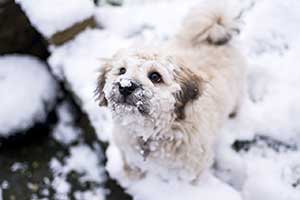
When the season changes and the temperature drops, do you bundle your dog up to protect them from the cold? Most owners don’t.
Many people think that a dog’s coat is enough to keep them warm as they frolic through the snow. Unfortunately, sometimes a thick coat of fur just isn’t enough.
Dogs are sensitive to the cold and will react to it the same way we do.
It’s true, some dogs are more susceptible to lower temperatures than others. However, just because a dog looks like they’re designed to withstand freezing temperatures doesn’t mean that their bodies aren’t being affected.
It’s important that you keep your canine companion safe from the elements.
You don’t have to bundle them up in a puffy winter coat every time you go outside for a walk. However, you do need to keep a close watch on your dog and know when to take them inside for some comfort.
Dogs can only handle so much cold at one time, so it’s your job to know your pup’s limits and understand the signs telling you that they have had enough.
The Risks of Over-Exposure
It’s easy to lose track of time, especially when you’re outside having fun with your dog. Unfortunately, problems can start to occur pretty quickly if you’re not paying attention.
Typically, large dogs with thick fur coats are capable of staying outside for much longer than small dogs.
Smaller pups with short hair can start to feel the effects of winter within minutes. Failing to warm your dog up can lead to a host of serious health problems.
Hypothermia
Hypothermia happens when your dog has been outside too long.
Their natural defenses against the cold weather have started to fail them, resulting in a pretty significant drop in overall body temperatures.
Dogs are naturally warmer than up humans. They typically have a body temperature between 101 and 102.5 degrees Fahrenheit.
The longer your dog is outside, the more their core body temperature will go down. Once their temperature falls to 99 degrees or less, they will start to exhibit signs of hypothermia. This includes heavy shaking, shock, and difficulty walking.
Frostbite
Frostbite is another ailment you need to be wary of. It’s an issue that could affect their body for the rest of their life.
Essentially, the body goes into survival mode.
Blood flow is sent to important parts of your dog’s body automatically. Unfortunately, this leaves many areas without the proper circulation to keep them warm.
The tips of the ears, paws, nose, and tail may start to become red or black. The tissue underneath the skin freezes due to the lack of blood flow.
Illness
Finally, your dog could catch a cold.
While this may not seem like a huge deal, any type of illness should be taken seriously. Dogs aren’t capable of fighting off germs when their body starts to shut down from the cold.
As a result, they may catch the flu. This could progress into something far worse if left untreated.
How to Tell if Your Dog is Cold
The best way to avoid concerns like hypothermia and frostbite is to warm up your dog the moment they start feeling too cold.
Because dogs can’t just tell you that they’re feeling a bit chilly, you need to watch their body language and the environment.
It’s crucial that you use your best judgment and always err on the side of caution when it comes to these symptoms.
#1. Check Your Environment

Exactly how cold is it outside? Don’t just take temperature readings at face value.
Many things, such as wind chill, ice, and sunshine, can make the spot your dog is playing in feel much different than what your local weather station says.
Pay attention to how cold it feels when you’re outside and try to put your self in your dog’s shoes
Chances are, you’ll be wearing a jacket. Do you still feel cold despite the protection your coat offers? If so, your dog is probably feeling the same things.
Fur can only provide so much insulation. If you’re having trouble staying outside even when you’re bundled up, your dog is presumably feeling the effects as well.
#2. Listen to Your Dog
While they can’t come right out and tell you how they are feeling, dogs will do their best to let you know when they are not comfortable.
Stay close to your pooch so that you can keep an ear out for any whining or soft barks.
Even hushed grumbles may be their way of telling you that they want to go back inside.
#3. Understand Physical Signs
One of the first things that will happen as your dog starts to get cold is shaking.
Dogs have the same physical response to extreme thermal changes as humans do. It’s the body’s way of trying to generate heat on its own.
The act is involuntary. It may start off small with slight trembling. However, that shudder can turn into a continuous shake within moments.
At this point, you should take your dog inside to avoid any future issues.
#4. Check Your Dog’s Behavior
In addition to listening for your dog’s voice, keep a watchful eye on their movements.
There are many telltale signs that your dog isn’t feeling the weather. The biggest is trying to find shelter on their own.
Your dog may try huddling behind a chair or large object to shield themselves from the wind. If you’re close by, they may even try to huddle next to your leg in an attempt to get a bit warmer.
In the event that you’re not close by, you may even see them lay down and curl up in a ball so that they can use their own body heat for warmth.
Their Demeaner
You should also pay attention to their demeanor. Do they look anxious or excited? If it’s the former, there’s a good chance that there is something wrong with your precious pooch.
Dogs tend to slow down significantly when they start to feel cold.
Their bones get a bit stiffer, making their movements seem forced and uncomfortable. Take this as a sign that they need to be warmed up.
Limping may also occur. This often indicates that their feet are too cold to walk normally.
It’s important to remember that dogs don’t have a ton of protection on the bottom of their feet. Even long-haired dogs have bare pads that make direct contact with the ground.
Snow and Ice
Snow and ice are going to be significantly colder than the air around you, so your dog might have pain and numbness in their paws that’s preventing them from walking like they normally do.

The biggest red flags for body language are clumsiness and lethargy.
As your dog’s body temperature starts to decrease, they won’t have the energy or mental coherence to behave normally.
This typically results in the dog laying down or falling over.
When this happens, you need to bring your dog to a warm place immediately. These are signs of hypothermia, so you need to act fast. Wrap your dog in a warm blanket and call your veterinarian.
You need to keep professional veterinary assistance as soon as possible to avoid any lasting effects.
#5. Feel Your Dog’s Body
As mentioned earlier, hypothermia is a direct result of your pup’s body temperature dropping to an unhealthy level.
You can monitor their temperature by simply touching them. Even in the cold, your dog’s body should feel warm.
If it doesn’t, they’re likely getting close to the danger point. Also, feel their ears. This can help you check to see if they are at risk for frostbite on the tips.
Conclusion
Dealing with the winter cold is never fun, even for dogs. The colder months are always hard on canines. There’s no way to avoid having to go outside, so they have to brave the frigid temperatures every day.
To keep your dog safe, happy, and healthy, keep your eyes peeled for symptoms that your pup is cold.
Knowing how to identify the signs may buy you valuable time to save your dog’s life and prevent lasting ailments.
Also Read: Best Dog Food for the Sensitve Stomach

